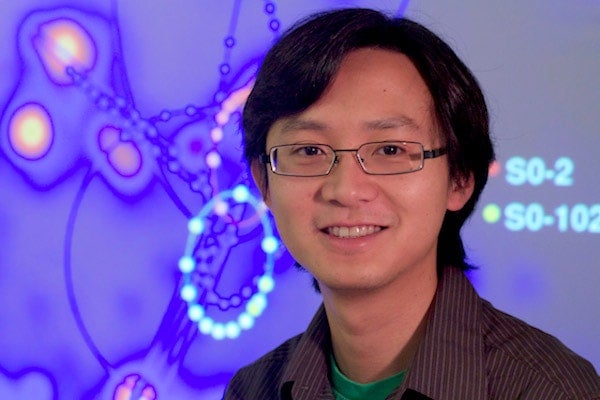
Around the Milky Way in 11.5 years
Published: October 5, 2012
An international team of astronomers, including the Dunlap Institute’s Tuan Do, has discovered a star that orbits the supermassive black hole at the centre of the Milky Way Galaxy in record time.
Referred to as S0-102, the star circuits our galaxy’s centre in a mere 11.5 years – less time than Jupiter takes to orbit the Sun.
“Because of its proximity to the giant black hole," says Do, "S0-102 gives us an excellent opportunity to test Einstein’s General Relativity.”
Do is part of the UCLA Galactic Center Group, led by Professor Andrea Ghez. The team’s findings were published in the journal Science on October 5th and are the latest results from the group’s 17-year effort.
It was by studying the stars in the Milky Way Galaxy’s core that Ghez and her team had previously discovered the supermassive black hole. Known as Sgr A* (Sagittarius A-star), the prodigious object contains the mass of four million stars equal in mass to our Sun.
“Having proved that black holes exist,” says Ghez, “our research today aims to understand their nature and how they warp space and time.”
There are thousands of stars within a few light-years of our galaxy’s centre, explains Do, a co-author on the Science paper.
“This region is the most extreme environment in the galaxy," Do says. "It has the highest density of stars—equivalent to having over a million stars between the Sun and our closest neighbor star, Alpha Centauri. The stars closest to Sgr A* are travelling at over 4000 kilometres per second.
"That’s one per cent of the speed of light.”
The previous stellar record holder for orbiting Sgr A* was a star called S0-2 with a galactic orbital period of 16 years. According to General Relativity, the elliptical orbits of objects like S0-2 and S0-102 should themselves “rotate”, creating a rosette-pattern over time. This motion is known as precession and is most easily observed in bodies orbiting close to massive objects.
But the mass of other stars near the galaxy’s centre causes a different type of precession which is hard to separate from precession caused by General Relativity. By studying the orbits of S0-02 and S0-102 together, the Galactic Center Group will be able to distinguish between the two precessions—making it possible to test the accuracy of Einstein’s prediction.
S0-102 was discovered using images taken with the twin 10-metre telescopes of the Keck Observatory on the summit of Mauna Kea in Hawai’i. These included observations with the Keck II telescope using adaptive optics and laser guide-star technology which correct for distortions caused by the Earth’s atmosphere. The observations made it possible to resolve individual stars in the crowded galactic core and determine their orbits.
Do joined the Dunlap Institute in the summer of 2012, where he will continue to work with the UCLA group in preparation for observations of the galactic centre using the next generation Thirty Meter Telescope (TMT). Canada is a major partner in the development of the TMT which, when it begins operation later this decade, will be the largest optical telescope ever built.
It will be capable of producing images ten times sharper than the Hubble Space Telescope.
The Dunlap Institute’s Professor Shelley Wright, David Law and Do are part of an international group developing an imaging spectrograph—called IRIS—which will be among the first instruments in operation on the TMT. The Galactic Center Group expects that IRIS will substantially improve the measurements for S0-102 and lead to the discovery of many, even shorter-period stars.
These observations will in turn reveal just how drastically space and time are warped in the heart of our galaxy.



